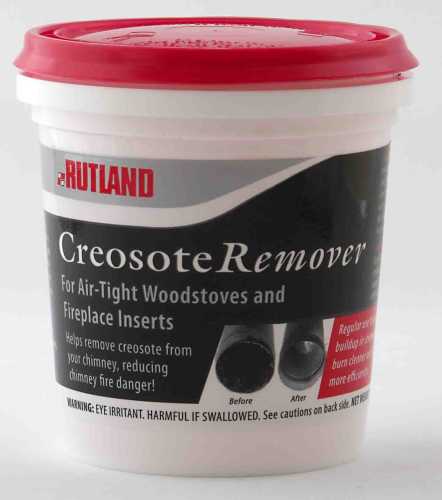If you have a traditional fireplace or any type of heating stove, your flue creates a draft and guides smoke away from your home. That same flue also collects materials from your burnt wood that end up lining your flue. That material makes your fire less effective and can also become a serious fire hazard.
The material is called creosote. In this article, we look at what creosote is, how it is made, and how you can remove and reduce the accumulation in your stove and fireplace.
What is Creosote?
Creosote is a flammable mixture of compounds made from a distilled blend of tar, organic vapors, and moisture resulting from burning wood and coal. It can be yellow, dark brown, or black and has a glossy sheen. Creosote can come as a liquid, gel, or solid. When solid, it can be flaky, crusty, or even hard and shiny. As a liquid or gel, it is often sticky to the touch.
Creosote often has a strong, pungent odor similar to tar on a freshly paved road.
How Does Your Chimney Create Creosote?
When you light a fire in your fireplace, the heat from the burning wood rises inside the chimney and evaporates moisture inside the chimney. The vaporized water mixes with smoke from the fire, and as the mixture cools, it condenses on the chimney's walls. The dryer the mixture gets from this distillation process, the harder and more flakey it becomes.
Since water vapor is an ingredient for forming creosote, wet wood will increase your chances and quantity of creosote.
Why is Creosote Bad?
Generally speaking, creosote isn't always bad, but it is when it is inside chimneys. Creosote is often applied to wood, such as road ties and utility poles, to preserve and protect the wood from termites, fungi, mites, and other insects.
Still, creosote is highly flammable, and that isn't good news for your home. In fireplaces and stoves, creosote inside a chimney can become so hot that it can ignite to become a fire hazard. Creosote can even cause chimney fires even if there is no open flame. All it takes is one spark from the fireplace to cause the creosote will ignite.
How Do I Know if I Have Creosote
You can check for creosote by looking inside your chimney with a flashlight and mirror. Hold the mirror to the opening of your chimney and use the flashlight to shine a light inside. If you see a black or dark brown substance on the walls of your chimney, it is likely creosote.
How Do I Remove Creosote?
If you have a small amount of creosote buildup, you can remove it with soap and water, creosote-busting fire logs, and special creosote-removing powders or liquids. For harder, dryer creosote, you can use a stiff brush or a power washer. If the buildup is too severe and challenging to remove, you may need to have your chimney relined.
One product worth using is Rutland Creosote Remover. When you pour a scoop of the powder onto hot coals once or twice a week, it turns the creosote into ash that can then be brushed out of your chimney easily. At the same time, it prevents future buildups. This video provides a better understanding of how the product works.
You can use this powder with a standard chimney and a wood-burning system.
Another product we often recommend is Co-Mate. It avoids harsh chemicals, using specially formulated mineral compounds to change the physical nature of the creosote to reduce its flammability and prevent new creosote from building inside your fireplace. It also allows you to burn your fuel faster and more completely.
The powder works with any chimney type and is odorless, non-toxic, and non-flammable, letting you add it as needed without worry.
How Do I Prevent Creosote Build-Up?
In addition to regularly using creosote-preventing products like those above, the best way to avoid issues that come with creosote is to spot it early and do frequent cleaning. You should check the flue every few weeks during use and at least once a year to ensure there isn't an excessive buildup.
In addition to cleaning, avoid woods that increase your creosote buildup. Avoid any wet and dry woods like fur, pine, and cedar.
How to Stop Chimney Fires
If your creosote builds up thick enough, you risk a severe chimney fire that can reach temperatures 2,000 degrees Fahrenheit or more. All that heat can ignite other areas of your home – including your roof. When a fire breaks out, any water used to distinguish the fire creates additional damage, raising the price of repairs even higher.
Thankfully, some products can aid in putting out a chimney fire quickly and cost-effectively. One recommended product is Chimfex. All you do is light the product, put it inside the fire, and close all the air openings, like the front window and vents. The fumes from the product then put out the fire while creating no water damage.


/1003/site-assets/logo.png)


